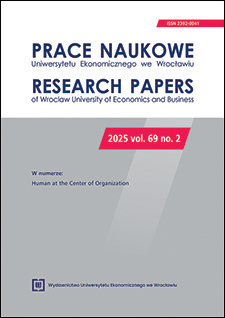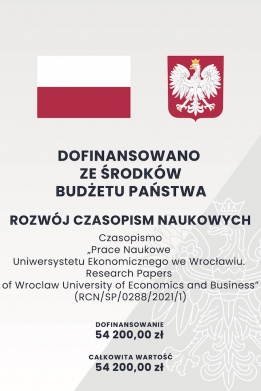Motywacja pracowników w służbach mundurowych − analiza bibliometryczna
DOI:
https://doi.org/10.15611/pn.2025.2.11Słowa kluczowe:
motywacja, służby mundurowe, model teoretycznyAbstrakt
Cel: Niniejszy artykuł ma na celu usystematyzowanie wiedzy na temat motywacji w służbach munduro-wych i określenie kierunków przyszłych badań.
Metodyka: Przeprowadzono analizę bibliometryczną, opierając się na publikacjach dostępnych w bazach Web of Science i Scopus. Objęła ona publikacje zawierające frazy „motywacja” i „służby mundurowe” lub „policja” lub „wojsko” lub „straż graniczna” lub „straż pożarna” lub „służba więzienna” w temacie. Wyszukiwanie zostało przeprowadzone dla materiałów opublikowanych w latach 2004-2024 w języku angielskim.
Wyniki: Na motywację w służbach mundurowych wpływają struktura, hierarchia, marka organizacji, regulacje prawne, wynagrodzenie oraz misja. Struktura i hierarchia wspierają motywację wewnętrzną poprzez jasny podział ról, możliwości awansu i szkolenia. Motywację zewnętrzną wzmacniają opieka zdrowotna, wsparcie psychologiczne i system nagród. Silna marka organizacji buduje dumę i identyfikację, co wpływa na obie formy motywacji. Wynagrodzenie jest kluczowym czynnikiem zewnętrznym, ale może też wzmacniać motywację wewnętrzną, jeśli jest postrzegane jako sprawiedliwe.
Implikacje i rekomendacje: Chociaż wynagrodzenie jest głównym motywatorem, ważną rolę odgrywają także awans, rozwój i szkolenia. Systemy motywacyjne powinny być dopasowane do kultury i specyfiki organizacji, aby skutecznie zwiększać zaangażowanie i realizację celów.
Oryginalność/wartość: Artykuł zawiera oryginalne wyniki badań. Mają one walory poznawcze i utylitarne.Pobrania
Bibliografia
Abdelnour, S., Hasselbladh, H., & Kallinikos, J. (2017). Agency and Institutions in Organization Studies. Organization Studies, 38(12), 1775-1792. https://doi.org/10.1177/0170840617708007
Alves, J. S. C., Bendassolli, P. F., & Gondim, S. M. G. (2017). Emotional Labor and Burnout: A Study with the Military Police. Avances en Psicologia Latinoamericana, 35(5), 459-472, https://doi.org/10.12804/revistas.urosario.edu.co/apl/a.4505
Basalamah, M. S. A., & As’ad A. (2021). The Role of Work Motivation and Work Environment in Improving Job Satisfaction. Golden Ratio of Human Resource Management, 1(2), 94-103, https://doi.org/10.52970/grhrm.v1i2.54
Bedwell, W. L., Wildman, J. L., Diaz Granados, D., Salazar, M., Kramer, W. S., & Salas, E. (2012). Collaboration at Work: An Integrative Multilevel Conceptualization. Human Resource Management Review, 2(92), 128-145. https://doi.org/10.1016/j.hrmr.2011.11.007
Beśka, B. (2020). Motivation – Definitions, Types and Motivations of Young People Joining the Police. Family Pedagogy, 3(10), 5-20.
Binková, K., & Štěpánková, E. (2023). Motivation of Men and Women to Join the Armed Forces. Proceedings of the 6th International Conference on Gender Research, 6(1), 37-46, https://doi.org/10.34190/icgr.6.1.1011
Bodziany, M., Ścibiorek, Z., & Ślusarczyk, S. (2021). Motivating in Theory and Practice of Command – Case Study of the Polish Armed Forces, the Police and the Fire Service. International Journal of Organizational Analysis, 29(2), 474-492. https://doi.org/10.1108/IJOA-02-2020-2044
Boies, K., & Howell, J. M. (2006). Leader–Member Exchange in Teams: An Examination of the Interaction between Relationship Differentiation and Mean LMX in Explaining Team-Level Outcomes. Leadership Quarterly, 17(3) 246-257. https://doi.org/10.1016/j.leaqua.2006.02.004
Bornmann, L., & Haunschild, R. (2017). Quality and Impact Considerations in Bibliometrics: A Reply to Ricker. Scientometrics, 111(3), 1857-1859. https://doi.org/10.1007/s11192-017-2373-3
Brunetto, Y., Teo, S., Shacklock, K., & Farr-Wharton, R. (2012). Emotional Intelligence, Job satisfaction, Well-Being and Engagement: Explaining Organisational Commitment and Turnover Intentions in Policing. Human Resource Management Journal, 22(4), 428-441. https://doi.org/10.1111/j.1748-8583.2012.00198.x
Brussen, M., & Sanders, K. (2014). The Relationship between Reflection and Innovative Behavior of Dutch Fire Brigade Leaders: Considering the Influence of Self-Efficacy, Time for Reflection and Autonomy. Gedrag & Organisatie, 27(3), 269-289.
Ceribeli, H. B., De Freitas, V. F., Rezende, A. F., & Sabin, K. L. C. (2020). Perceived Organizational Prestige, Organizational Identification and Emotional Exhaustion of Military Police Officers. Revista Gestao Organizacional, 13(2), 26-47.
Cichowicz, E., & Rollnik-Sadowska, E. (2018). Inclusive Growth in CEE Countries as a Determinant of Sustainable Development. Sustainability, 10(11), https://doi.org/10.3390/su10113973
Cole, M. S., Bernerth, J. B., Walter, F., & Holt, D. T. (2010). Organizational Justice and Individuals’ Withdrawal: Unlocking the Influence of Emotional Exhaustion. Journal of Management Studies, 47(3), 367-390. https://doi.org/10.1111/j.1467-6486.2009.00864.x
Cortina, L. M., Kabat-Farr, D., Leskinen, E. A., Huerta, M., & Magley, V. J. (2013). Selective Incivility as Modern Discrimination in Organizations: Evidence and Impact. Journal of Management, 39(6), 1579-1605. https://doi.org/10.1177/0149206311418835
Czerniawska, M., & Szydło, J. (2020). The Worldview and Values – Analysing Relations. WSEAS Transactions on Business and Economics, 17, 594-607. https://doi.org/10.37394/23207.2020.17.58
Deci, E. L., & Ryan, R. M. (1985). Intrinsic Motivation and Self-Determination in Human Behavior. Plenum Press.
Demirkol, I. C. (2021). The Role of Police Occupational Culture on Officers’ Job Satisfaction and Work Motivation. International Journal of Comparative and Applied Criminal Justice, 45(4), 357-375. https://doi.org/10.1080/01924036.2020.1742173
Demirkol, I. C., & Nalla, M. K. (2018). Enhancing Motivation and Job Satisfaction of Police Officers: A Test of High Performance Cycle Theory. Criminal Justice and Behavior, 45(12), 1903-1917. https://doi.org/10.1177/0093854818796873
Dick, G., & Metcalfe, B. (2007). The Progress of Female Police Officers: An Empirical Analysis of Organisational Commitment and Tenure Explanations in Two UK Police Forces. The International Journal of Public Sector Management, 20(2), 81-100. https://doi.org/10.1108/09513550710731463
Dos Santos, R. C., Rodrigues, A. L., de Lima, T. C. B., & Araújo, R. de A. (2023). Identidade profissional e estigma: um estudo com policiais militares. Revista De Gestão E Secretariado, 14(5), 6877-6893. https://doi.org/10.7769/gesec.v14i5.2086
Dragomir, C., Bina, M. V., & Mititelu, L. (2018). Motivation of Personnel – Essential Part of Leadership in the Military Organization. Scientific Research and Education in the Air Force. https://doi.org/10.19062/2247-3173.2018.20.63
Fialho, L. M. F, Pereira, E. M. S., & Sousa, F. G. A. (2023). Training Course for CEAR. Military Police Officials from the Police Perspective, HOLOS, 39(3).
Filgona, J., Sakiyo, J., Gwany, D. M., & Okoronka, A. U. (2020). Motivation in Learning. Asian Journal of Education and Social Studies, 10(4), 16-37. https://doi.org/10.9734/AJESS/2020/v10i430273
Forner, V. W., Jones, M., Berry, Y., & Eidenfalk, J. (2020). Motivating Workers: How Leaders Apply Self-Determination Theory in Organizations. Organization Management Journal, 18(2), 76-94. https://doi.org/10.1108/OMJ-03-2020-0891
Frohlich, S., Fernandes, C., Rosalia Ribeiro Silva, M., & Lemos Lourenço, M. (2022). Work Passion in the Military Career: A Study on Military Policies and Firefighters in Peacekeeping Missions. Teoria E Prática Em Administração, 12(1), https://doi.org/10.22478/ufpb.2238-104X.2022v12n1.59503
Fry, L., Vitucci, S., & Cedillo, M. (2005). Spiritual Leadership and Army Transformation: Theory, Measurement, and Establishing a Baseline. Leadership Quarterly, 16(5), 835-862. https://doi.org/10.1016/j.leaqua.2005.07.012
Gillet, N., Huart, I., Colombat, P., & Fouquereau, E. (2013). Perceived Organizational Support, Motivation, and Engagement among Police Officers. Professional Psychology: Research and Practice, 44(1), 46-55. https://doi.org/10.1037/a0030066
Glińska, E., & Siemieniako, D. (2018). Binge Drinking in Relation to Services – Bibliometric Analysis of Scientific Research Directions. Engineering Management in Production and Services, 10(1), 45-54. https://doi.org/10.1515/emj-2018-0004
Gomes, A.R. & Afonso, J. M. P. (2016). Occupational Stress and Coping among Portuguese Military Police Officers. Avances en Psicologia Latinoamericana, 34(1), 47-65. https://doi.org/10.12804/apl34.1.2016.04
Grigorov, G., & Spirdonov, S. (2018). Research on the Motivation for Choosing the Military Career. Conference Proceedings of the 24th International Conference the Knowledge-Based Organization, 24(1), 302-307. https://doi.org/10.1515/kbo-2018-0048
Gudanowska, A. E. (2017). Modern Research Trends within Technology Management in the Light of Selected Publications. Procedia Engineering, 182, 247-254. https://doi.org/10.1016/j.proeng.2017.03.185
Guterresa, L., Armanu, A., & Rofiaty, R. (2020). The Role of Work Motivation as a Mediator on the Influence of Education-Training and Leadership Style on Employee Performance. Management Science Letters, 10(7), 497-1504. https://doi.org/10.5267/j.msl.2019.12.017
Halpenny, A. (2010). The Governance of Military Police in Canada. Osgoode Hall Law Journal, 48(1).
Hardy, L., Calum, A. A, Jones, G., Shariff, A., Munnoch, K., Isaacs, I., & Allsopp, A. J. (2010). The Relationship between Transformational Leadership Behaviors, Psychological, and Training Outcomes in Elite Military Recruits. Leadership Quarterly, 21(1), 20-32. https://doi.org/10.1016/j.leaqua.2009.10.002
Holmberg, A., & Alvinius, A. (2024). Organizational Resistance through Organizing Principles: The Case of Gender Equality in the Military. Gender in Management, 39(3), 313-327. https://doi.org/10.1108/GM-05-2022-0180
Hudson, S., Ridland, L., Blackburn, J., Monchuk, L., & Ousey, K. (2024). The Comfort and Functional Performance of Personal Protective Equipment for Police Officers: A Systematic Scoping Review. Ergonomics, 67(10), 1317-1337. https://doi.org/10.1080/00140139.2024.2302957
Ihensekien, O. A., & Joel, A. C. (2023). Abraham Maslow’s Hierarchy of Needs and Frederick Herzberg's Two-Factor Motivation Theories: Implications for Organizational Performance. Romanian Economic Journal, 85, 32-49. https://doi.org/10.24818/REJ/2023/85/04
Indahingwati, A., Launtu, A., Tamsah, H., Firman, A., Putra, A. H. P. K., & Aswari, A. (2019). How Digital Technology Driven Millennial Consumer Behaviour in Indonesia. Journal of Distribution Science, 17(8), 25-34. https://doi.org/10.15722/jds.17.8.201908.25
Jaworski, B. (2019). Appraisal of Officers. Acta Universitatis Lodziensis. Folia Iuridica, 87, 105-117. https://doi.org/10.18778/0208-6069.87.07
Kalogiannidis, S. (2021). Impact of Employee Motivation on Organizational Performance. A Scoping Review Paper for the Public Sector. The Strategic Journal of Business & Change Management, 8(3), 984-996. https://doi.org/10.61426/sjbcm.v8i3.2064
Keathley-Herring, H., Van Aken, E., Gonzalez-Aleu, F., Deschamps, F., Letens, G., & Orlandini, P.C. (2016). Assessing the Maturity of a Research Area: Bibliometric Review and Proposed Framework. Scientometrics, 109(2), 927-951. https://doi.org/10.1007/s11192-016-2096-x
Khoshnevis, H., & Tahmasebi, A. (2016). The Motivation System in a Governmental Organization. Procedia − Social and Behavioral Sciences, 230, 212-218. https://doi.org/10.1016/j.sbspro.2016.09.027
Kim, D., & Vandenberghe, C. (2023). Social Exchange Relationships with Peer Leaders and Ethical Leadership: A Study among Male Military Team Leaders. Canadian Journal of Administrative Sciences, 40(3), 294-308. https://doi.org/10.1002/cjas.1701
Kioulepoglou, P., Chazapis, S., & Blundell J. (2024). A Comparative Analysis of Job Satisfaction among Military and Airline Pilots: During, and Post COVID-19. Research in Transportation Business & Management, 53. https://doi.org/10.1016/j.rtbm.2024.101103
Kirchner, M., & Akdere, M. (2017). Military Leadership Development Strategies: Implications for Training in Non-Military Organizations. Industrial and Commercial Training, 49(7-8), 357-364. https://doi.org/10.1108/ICT-06-2017-0047
Klein, G., Klein, H. A, Lande, B., Borders, J., & Whitarce, J. C. (2015). Police and Military as Good Strangers. Journal of Occupational and Organizational Psychology, 88(2), 231-250. https://doi.org/10.1111/joop.12110
Knopp, D. (2021). Motivational Factors in Uniformed Services. The Bellona Quarterly, 1, 45-59. https://doi.org/10.5604/01.3001.0014.8639
Kornberger, M., & Vaara, E. (2022). Strategy as Engagement: What Organization Strategy Can Learn from Military Strategy. Long Range Planning, 55(4). https://doi.org/10.1016/j.lrp.2021.102125
Krzewiński, T. (2018). Selected Aspects of Human Resource Management in Uniformed Services. International Journal of Synergy and Research, 7, 97-109. http://dx.doi.org/10.17951/ijsr.2018.7.0.97-109
Lenert Gansiniec, R. (2021). Systematyczny przegląd literatury w naukach społecznych. Przewodnik dla studentów, doktorantów i nie tylko. WN Scholar.
Lievens, F., Van Hoye, G., & Anseel F. (2007). Organizational Identity and Employer Image: Towards a Unifying Framework. British Journal Management, 18, 45-S59. https://doi.org/10.1111/j.1467-8551.2007.00525.x
Lim, B.-C., & Ployhart, R. E. (2004). Transformational Leadership: Relations to the Five-Factor Model and Team Performance in Typical and Maximum Contexts. Journal of Applied Psychology, 89(4), 610-621. https://doi.org/10.1037/0021-9010.89.4.610
Lu, L., Liu, L., Sui, G., & Wang, L. (2015). The Associations of Job Stress and Organizational Identification with Job Satisfaction among Chinese Police Officers: The Mediating Role of Psychological Capital. International Journal of Environmental Research and Public Health, 12(12), 15088-15099. https://doi.org/10.3390/ijerph121214973
Marczak, E., & Yawson, R. (2021). Understanding the Theories and Interventions of Motivation in Organization Development, Responsible Management: Opportunities and Challenges. Proceedings of 58th Annual Conference of the Eastern Academy of Management. Virtual. https://doi.org/10.2139/ssrn.3849393
Martin, K., Périard, J., Rattray, B., & Pyne, D. B. (2020). Physiological Factors Which Influence Cognitive Performance in Military Personnel. Human Factors, 62(1), 93-123. https://doi.org/10.1177/0018720819841757
McCarthy, J.M., Trougakos, J. P., & Cheng, B. H. (2016). Are Anxious Workers Less Productive Workers? It Depends on the Quality of Social Exchange. Journal of Applied Psychology, 101(2), 279-291. https://doi.org/10.1037/apl0000044
Miroshnichenko, V., Mashtaler, A., Stavytskyi, O., Bloshchynskyi, I., Pochekalin, I., & Shevchuk, V. (2019). Professional Vocation Development in the Future Border Guard Officers’ Activity. Revista Romaneasca pentru Educatie Multidimensionala, 11(4), 164-174. https://doi.org/10.18662/rrem/164
Moczydłowska, J. M. (2012). Talent Management: Theory and Practice of Management. The Polish Experience. International Journal of Business Economic Research, 3(1), 432-438.
Moczydłowska, J. M., & Kowalewski, K. (2014). Nowe koncepcje zarządzania ludźmi. Difin.
Moczydłowska, Z. S. (2023). Incentive System in the Uniformed Services on the Example of the Marshal Guard. Academy of Management, 7(4), 23-39. https://doi.org/10.24427/az-2023-0053
Mróz-Gorgon, B., Martusewicz, J., & Michaluk, A. (2020). Effective Leadership in The Organization − A Current Challenge in The Military Service. Education Excellence And Innovation Management: A 2025 Vision To Sustain Economic Development During Global Challenges. Proceedings Paper, 17926-17930.
Nazia, M., & Shoain, K. (2021). What Drives Young Women to Join the Pakistan Armed Forces? An Exploratory Study of Motivational Factors. Pakistan Armed Forces Medical Journal, 71(71), 1346-1350, https://doi.org/10.51253/pafmj.v71i4.6274
Niñerola, A., Sánchez-Rebull, M.-V., & Hernández-Lara, A.-B. (2019). Tourism Research on Sustainability: A Bibliometric Analysis. Sustainability, 11(5), https://doi.org/10.3390/su11051377
Nissinen, V., Dormantaitė, A., & Dungveckis, L. (2022). Transformational Leadership in Military Education: Lithuanian Case Study. Management Theory and Studies for Rural Business and Infrastructure Development, 44(1), 103-116. https://doi.org/10.15544/mts.2022.11
Orlovic, A. (2018). Police management − Police Officers’ Perception of the Status (Qualitative Level) of Fundamental Functions of Management in the Police Organization. Interdisciplinary Management Research, 14, 286-305.
Osterberg, J., Nilsson, J., & Hellum, N. (2020). The Motivation to Serve in the Military among Swedish and Norwegian Soldiers. A Comparative Study. Journal of Defense Resources Management, 1(20), 30-42.
Paarlberg, L. E., & Lavigna, B. (2010). Transformational Leadership and Public Service Motivation: Driving Individual and Organizational Performance. Public Administration Review, 70(5), 710-718. https://doi.org/10.1111/j.1540-6210.2010.02199.x
Pancasila, I., Haryono, S., & Sulistyo, B. A. (2020). Effects of Work Motivation and Leadership toward Work Satisfaction and Employee Performance: Evidence from Indonesia. Journal of Asian Finance, Economics and Business, 7(6), 387-397. https://doi.org/10.13106/jafeb.2020.vol7.no6.387
Pârjoleanu, R. (2020). Work Motivation Efficiency in the Workplace. Postmodern Openings, 11(4), 293-309. https://doi.org/10.18662/po/11.4/236
Piontek, A. (2017). Factors Shaping the Satisfaction of Employees of a Selected Dispatch Group on the Example of the Police. Studies and Works WNEIZ US, 48(2), 269-279. https://doi.org/10.18276/sip.2017.48/2-23
Poklek, R. (2020). Professional Motivation of Officers Starting Work in Prison. Sociology Forum, 10, 229-242. https://doi.org/10.19195/2083-7763.10.17
Poklek, R. (2021). Professional Motivation of Prison Staff. Polish Prison Review, 70, 77-100.
Radchenko, E., Kozin, M. & Pyrchenkova G. (2020). Innovative Technologies In Science And Education (Itse-2020), (210). https://doi.org/10.1051/e3sconf/202021002004
Reizer, A., Brender-Ilan, Y., & Sheaffer, Z. (2019). Employee Motivation, Emotions and Performance: A Longitudinal Diary Study. Journal of Managerial Psychology, 34(6), 415-428. https://doi.org/10.1108/JMP-07-2018-0299
Ribeiro, A. D., & Garcia, F. C. (2015). Power and Gender Relations in the High Command of the Military Police of Minas Gerais: An Analysis of Perception of Women Police. Teoria E Prática Em Administração, 5(1), 53-79.
Ritz, A., Brewer, G. A., & Neumann, O. (2016). Public Service Motivation: A Systematic Literature Review and Outlook. Public Administration Review, 76(3), 414-426. https://doi.org/10.1111/puar.12505
Roach, K. (2011). Police Independence and the Military Police. Osgoode Hall Law Journal, 49(1), 117-149.
Robinson, K., McKenna, B., & Rooney, D. (2022). The Relationship of Risk to Rules, Values, Virtues, and Moral Complexity: What We can Learn from the Moral Struggles of Military Leaders. Journal of Business Ethics, 149, 749-766. https://doi.org/10.1007/s10551-021-04874-5
Saudelli, I., De Kimpe, S., & Christiaens, J. (2022). Police Stops, Suspicion and the Influence of Police Department Cultures: A Look into the Belgian Context. Journal of Organizational Ethnography, 11(2), 98-115. https://doi.org/10.1108/JOE-02-2021-0008
Scholarios, D., Hesselgreaves, H., & Pratt, R. (2017). Unpredictable Working Time, Well-Being and Health in the Police Service. International Journal of Human Resource Management, 28(16), 2275-2298. https://doi.org/10.1080/09585192.2017.1314314
Siderska, J., & Jadaa, K. S. (2018). Cloud Manufacturing: A Service-Oriented Manufacturing Paradigm. A Review Paper. Engineering Management in Production and Services, 10(1), 22-31. https://doi.org/10.1515/emj-2018-0002
Sitopu, Y. B., Sitinjak, K. A., & Marpaung, F. K. (2021). The Influence of Motivation, Work Discipline, and Compensation on Employee Performance. Golden Ratio of Human Resource Management, 1(2), 72-83. https://doi.org/10.52970/grhrm.v1i2.79
Szpilko, D., Jimenez Naharro, F., Lăzăroiu, G., Nica, E., & De la Torre Gallegos, A. (2023). Artificial Intelligence in the Smart City — a Literature Review. Engineering Management in Production and Services, 15(4), 53-75. https://doi.org/10.2478/emj-2023-0028
Szum, K. (2021). IoT-based Smart Cities: A Bibliometric Analysis and Literature Review. Engineering Management in Production and Services, 13(2), 115-136. https://doi.org/10.2478/emj-2021-0017
Szustakiewicz, P. (2019). The Issue of Unification of Regulations Governing the Service Relationship of Uniformed Officers. Internal Security Review, 11(21), 82-95.
Szymańska, E. (2017). Theoretical Aspects of Motivating Police Officers. Defense-Scientific Journals of the Faculty of Management and Command of the Academy of Military Arts, 4(24), 177-191.
Thomas, R., & Davies A. (2005). Theorizing the Micro-politics of Resistance: New Public Management and Managerial Identities in the UK Public Services. Organization Studies, 26(5), 683-706. https://doi.org/10.1177/0170840605051821
Thornborrow, T., & Brown, A. D. (2009). `Being Regimented’: Aspiration, Discipline and Identity Work in the British Parachute Regiment. Organization Studies, 30(4), 355-376. https://doi.org/10.1177/0170840608101140
Torichnyi, O., & Bhinder, N. (2019). Organizational Methods of Formation of Military and Special Competence in Future Border Guard Officers in the Continuing Education Process. Revista Romaneasca pentru Educatie Multidimensionala, 4(1), 278-301. https://doi.org/10.18662/rrem/190
Turkalj, Z., Orlovic, A., & Milkovic, I. (2016). Motivation for Work − Perceived Sources of Work Motivation of Police Officers (Profession, Organisation, Management). Interdisciplinary Management Research, 12, 404-415.
Uka, A., & Prendi, A. (2021). Motivation as an Indicator of Performance and Productivity from the Perspective of Employees. Management & Marketing, 16(3), 268-285. https://doi.org/10.2478/mmcks-2021-0016
Van den Heuvel, M., Demerouti, E., & Peeters, M. C. W. (2015). The Job Crafting Intervention: Effects on Job Resources, Self--Efficacy, and Affective Well-Being. Journal of Occupational and Organizational Psychology, 88(2), 1-22. https://doi.org/10.1111/joop.12128
Van Knippenberg, D., Van Knippenberg, B., De Cremer, D., & Hogg, M. A. (2004). Leadership, Self, and Identity: A Review and Research Agenda. Leadership Quarterly, 15(6), 825-856. https://doi.org/10.1016/j.leaqua.2004.09.002
White, M. D., Cooper, J. A., Saunders, J., & Raganella, A. J. (2010). Motivations for Becoming a Police Officer: Re-Assessing Officer Attitudes and Job Satisfaction after Six Years on the Street. Journal of Criminal Justice, 38(4), 520-530. https://doi.org/10.1016/j.jcrimjus.2010.04.022
Wiśniewski, R. (2019). The Role of Incentive Systems of the Uniformed Services in the Formation of State Security. Internal Security Review, 11(20), 92-112.
Zheng, J. (2021). A Functional Review of Research on Clarity, Immediacy, and Credibility of Teachers and Their Impacts on Motivation and Engagement of Students. Frontiers of Psychology, 12, 1-10. https://doi.org/10.3389/fpsyg.2021.712419
Pobrania
Opublikowane
Licencja
Prawa autorskie (c) 2025 Joanna Szydło, Zuzanna Sara Moczydłowska

Utwór dostępny jest na licencji Creative Commons Uznanie autorstwa – Na tych samych warunkach 4.0 Miedzynarodowe.
Accepted 2024-11-12
Published 2025-07-22









